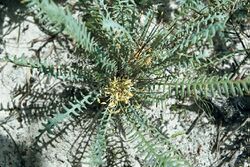Biology:Banksia nana
| Dwarf dryandra | |
|---|---|

| |
| Scientific classification | |
| Kingdom: | Plantae |
| Clade: | Tracheophytes |
| Clade: | Angiosperms |
| Clade: | Eudicots |
| Order: | Proteales |
| Family: | Proteaceae |
| Genus: | Banksia |
| Subgenus: | Banksia subg. Banksia |
| Series: | Banksia ser. Dryandra |
| Species: | B. nana
|
| Binomial name | |
| Banksia nana (Meisn.) A.R.Mast & K.R.Thiele[1]
| |
| Synonyms[1] | |
| |
Banksia nana, commonly known as dwarf dryandra,[2] is a species of shrub that is endemic to a small area in the south-west of Western Australia. It has underground stems, pinnatipartite leaves with sharply-pointed lobes, pale green or yellow flowers and broadly egg-shaped follicles.
Description
Banksia nana is a shrub with short, hairy, underground stems and a small lignotuber. The leaves are pinnatipartite, 40–190 mm (1.6–7.5 in) long and 10–24 mm (0.39–0.94 in) wide on a petiole up to 10 mm (0.39 in) long. There are between ten and thirty-five sharply-pointed lobes on each side of the leaves. Between twelve and seventeen pale green or yellow flowers are arranged in a head on the ends of branches, with egg-shaped to lance-shaped involucral bracts up to 10 mm (0.39 in) long at the base of the head. The perianth is 33–34 mm (1.3–1.3 in) long and the pistil 68–79 mm (2.7–3.1 in) long and curved. Flowering occurs in October and the follicles are broadly egg-shaped, 13–14 mm (0.51–0.55 in) long.[2][3]
Taxonomy and naming
This species was first formally described in 1855 by Carl Meissner who gave it the name Dryandra nana and published the description in Hooker's Journal of Botany and Kew Garden Miscellany from specimens collected by James Drummond.[4][5] The specific epithet (nana) is a Latin word meaning "dwarf".[6] In 2007 Austin Mast and Kevin Thiele transferred all dryandras to the genus Banksia and renamed this species Banksia nana.[7][8]
Distribution and habitat
Banksia nana grows in kwongan on low hills near Badgingarra in the Geraldton Sandplains and Swan Coastal Plain biogeographic regions.[2][3]
Conservation status
This banksia is classified as "Priority Three" by the Government of Western Australia Department of Parks and Wildlife,[2] meaning that it is poorly known and known from only a few locations but is not under imminent threat.[9]
References
- ↑ 1.0 1.1 "Banksia nana". https://biodiversity.org.au/nsl/services/apc-format/display/205143.
- ↑ 2.0 2.1 2.2 2.3 "Banksia nana". FloraBase. Western Australian Government Department of Parks and Wildlife. https://florabase.dpaw.wa.gov.au/browse/profile/32206.
- ↑ 3.0 3.1 George, Alex S. (1999). Flora of Australia. 17B. Canberra: Australian Biological Resources Study, Canberra. p. 349. https://www.environment.gov.au/system/files/pages/6d8c5c3b-8545-437e-b9b3-944ac95ee07a/files/flora-australia-17b-proteaceae-3-hakea-dryandra.pdf. Retrieved 17 May 2020.
- ↑ "Dryandra nana". APNI. https://id.biodiversity.org.au/instance/apni/528353.
- ↑ Meissner, Carl; Hooker, William J. (1855). "New Proteaceae of Australia". Hooker's Journal of Botany and Kew Garden Miscellany 7: 121. https://www.biodiversitylibrary.org/item/6325#page/123/mode/1up. Retrieved 17 May 2020.
- ↑ Francis Aubie Sharr (2019). Western Australian Plant Names and their Meanings. Kardinya, Western Australia: Four Gables Press. p. 259. ISBN 9780958034180.
- ↑ Mast, Austin R.; Thiele, Kevin (2007). "The transfer of Dryandra R.Br. to Banksia L.f. (Proteaceae)". Australian Systematic Botany 20 (1): 63–71. doi:10.1071/SB06016.
- ↑ "Banksia nana". APNI. https://id.biodiversity.org.au/instance/apni/614292.
- ↑ "Conservation codes for Western Australian Flora and Fauna". Government of Western Australia Department of Parks and Wildlife. https://www.dpaw.wa.gov.au/images/documents/plants-animals/threatened-species/Listings/Conservation%20code%20definitions.pdf.
- Cavanagh, Tony and Margaret Pieroni (2006). The Dryandras. Melbourne: Australian Plants Society (SGAP Victoria); Perth: Wildflower Society of Western Australia. ISBN 1-876473-54-1.
Wikidata ☰ Q51042893 entry
 |


